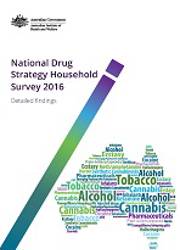Summary
This report expands on the key findings from the 2016 National Drug Strategy Household Survey (NDSHS) that were released on 1 June 2017. It presents more detailed analysis including comparisons between states and territories and for population groups. Unless otherwise specified, the results presented in this report are for those aged 14 or older.
1 in 8 Australians smoke daily and 6 in 10 have never smoked
- Smoking rates have been on a long-term downward trend since 1991, but the daily smoking rate did not significantly decline over the most recent 3 year period (was 12.8% in 2013 and 12.2% in 2016).
- Among current smokers, 3 in 10 (28.5%) tried to quit but did not succeed and about 1 in 3 (31%) do not intend to quit.
- People living in the lowest socioeconomic areas are more likely to smoke than people living in the highest socioeconomic area but people in the lowest socioeconomic area were the only group to report a significant decline in daily smoking between 2013 and 2016 (from 19.9% to 17.7%).
8 in 10 Australians had consumed at least 1 glass of alcohol in the last 12 months
- The proportion exceeding the lifetime risk guidelines declined between 2013 and 2016 (from 18.2% to 17.1%); however, the proportion exceeding the single occasion risk guidelines once a month or more remained unchanged at about 1 in 4.
- Among recent drinkers: 1 in 4 (24%) had been a victim of an alcohol-related incident in 2016; about 1 in 6 (17.4%) put themselves or others at risk of harm while under the influence of alcohol in the last 12 months; and about 1 in 10 (9%) had injured themselves or someone else because of their drinking in their lifetime.
- Half of recent drinkers had undertaken at least some alcohol moderation behaviour. The main reason chosen was for health reasons.
- A greater proportion of people living in Remote or very remote areas abstained from alcohol in 2016 than in 2013 (26% compared with 17.5%) and a lower proportion exceeded the lifetime risk guidelines (26% compared with 35%).
About 1 in 8 Australians had used at least 1 illegal substance in the last 12 months and 1 in 20 had misused a pharmaceutical drug
- In 2016, the most commonly used illegal drugs that were used at least once in the past 12 months were cannabis (10.4%), followed by cocaine (2.5%), ecstasy (2.2%) and meth/amphetamines (1.4%).
- However, ecstasy and cocaine were used relatively infrequently and when examining the share of Australians using an illegal drug weekly or more often in 2016, meth/amphetamines (which includes ‘ice’) was the second most commonly used illegal drug after cannabis.
- Most meth/amphetamine users used ‘ice’ as their main form, increasing from 22% of recent meth/amphetamine users in 2010 to 57% in 2016.
Certain groups disproportionately experience drug-related risks
- Use of illicit drugs in the last 12 months was far more common among people who identified as being homosexual or bisexual; ecstasy and meth/amphetamines use in this group was 5.8 times as high as heterosexual people.
- People who live in Remote and very remote areas, unemployed people and Indigenous Australians continue to be more likely to smoke daily and use illicit drugs than other population groups.
- The proportion of people experiencing high or very high levels of psychological distress increased among recent illicit drug users between 2013 and 2016 – from 17.5% to 22% but also increased from 8.6% to 9.7% over the same period for the non-illicit drug using population (those who had not used an illicit drug in the past 12 months).
- Daily smoking, risky alcohol consumption and recent illicit drug use was lowest in the Australian Capital Territory and highest in the Northern Territory.
The majority of Australians support policies aimed at reducing the acceptance and use of drugs, and the harms resulting from drug use
There was generally greater support for education and treatment and lower support for law enforcement measures.
Summary
1. Introduction
2. Overview
3. Tobacco
4. Alcohol
5. Illicit use of drugs
6. Misuse of pharmaceuticals
7. State and territory
8. Specific population groups
9. Perceptions and policy support
10. Explanatory notes
Appendix: Membership of the Technical Advisory Group
End matter: Acknowledgments; Abbreviations; Symbols; Glossary; References; Related publications



